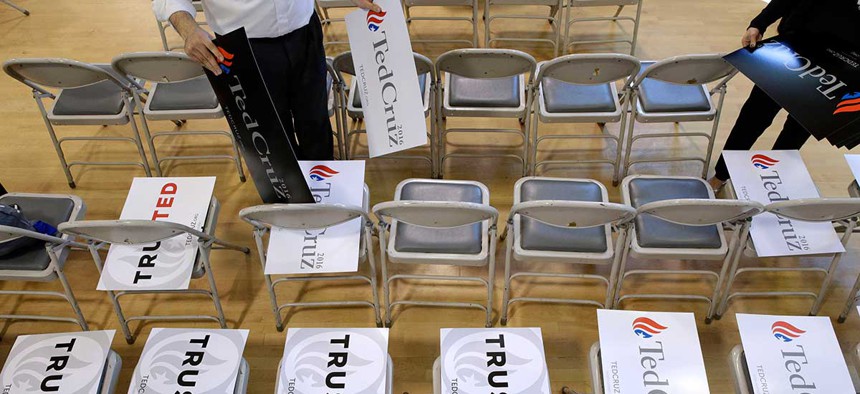
Patrick Semansky/AP
The United States Is Running Out of Undecided Voters
Ted Cruz and John Kasich need big wins in the remaining primaries for a shot at the nomination—too bad most people have already made up their minds.
What a week to be a presidential candidate. Ted Cruz picked former rival Carly Fiorina to be his running mate. John Kasich horse-traded Indiana for two other states. And Donald Trump actually made a policy speech.
Bold moves, fellas! After all, this is usually when campaigns enter naptime; by May, both parties normally have a presumptive nominee and are busying themselves with chair arrangements at the conventions. But as 2016 has already shown, this is An Election Like None Other. If Cruz and Kasich want a chance at winning the nomination, they have to seriously wow voters in these last handful of primaries. They’re clearly taking their best shots.
But here’s the thing: Bold, decisive campaigning only works if there are enough voters left who actually care. There’s still wiggle room in Indiana, where polls say somewhere around 6 percent of voters are undecided. But if I were one of the candidates, I’d be worried about a different figure: the percentage of people who made up their minds more than a month before the election. That number looks decidedly worse.
During elections, most exit polls ask voters how long ago they settled on their picks for president. There’s always a group that decides at the last minute, and they’re the best targets for glad-handing at the local donut shop. But there are also folks who made up their minds weeks before—even before a single candidate showed up in their state. Those voters are no longer reachable.
That particular slice of voters, which held steady for a while, has recently shot up. That makes sense: The longer the campaigns go on, the more people will have the information they need to settle on a candidate. In the last set of primaries—Pennsylvania, Maryland, Delaware, Connecticut, and Rhode Island—more than half the voters had already made their picks a month before Election Day, and three-quarters knew at least two weeks before, according to CNN.
A state that has largely made up its mind doesn’t mean an automatic Trump win—though he has typically done great among early deciders. But it’s a sign that there is less slack left in the electorate, and fewer people willing to be convinced. In Indiana, Trump leads Cruz by about 6 points , and only a third of voters there say they’re willing to change their minds. No matter how many babies the Texas senator kisses, he’s going to have a hard time moving those numbers.
Also, late-deciders—the folks who make their pick within the last two weeks before an election—are a pretty weird bunch. Research suggests they’re actually two groups. Here’s what a 2009 report in the The American Review of Politics had to say:
Our results indicate that the first group, low-interest late deciders, does seem to reinforce the negative stereotype of late-deciding voters … they are less partisan, less able to differentiate among the candidates, less concerned about the outcome of the election, less likely to pay attention to media coverage of the campaign, less knowledgeable about politics, and less politically active.
A smaller, but very distinct group of late-deciding voters, however, look surprisingly like early deciders in terms of their knowledge and attention to the campaign … they are less attached to the parties and candidates, and while they are ultimately influenced by their party identification to a significant degree, they would seem to be more willing to give each side a chance to state its case before reaching a conclusion.
This report focused on general elections. But its conclusions can be applied to primaries, too. Cruz needs the vote of that second group, the undecideds who have devoted critical thought to the coming contest. But given their similarity to early deciders—which have largely broken for Trump—he is likely at a disadvantage.
If current trends continue, more and more voters will have reached a decision long before their turn at the ballot box comes, making campaigning increasingly irrelevant. The curve plotted in the graph above will swiftly become outdated, but right now it suggests that 66 percent of Indiana’s voters made up their minds sometime around the beginning of April, a month before the state’s primary. More than 80 percent made their decisions before Pennsylvania and the other northeastern states that voted last week, according to the model. Assuming that holds true, only a fifth of the Indiana electorate will qualify as “late-deciding” voters—and an even smaller proportion will be politically engaged enough to be effectively swayed.
Democrats, by the way, haven’t changed much over the course of the campaign. In every primary, between 70 and 80 percent reported making up their minds more than two weeks before. One could argue that numbers that high indicate a greater loyalty to Democratic voters’ candidate of choice and perhaps has helped prolong Bernie Sanders’s time on the campaign trail, given the hidden wellspring of support he has tapped.
The GOP would love to see that kind of loyalty. Unfortunately for them, the only candidate who has gotten it is Trump. Cruz and Kasich are entering the finale of this particular fireworks show, and they’re holding nothing back. It will be a sight to see. Too bad everyone packed up and left a month ago.






